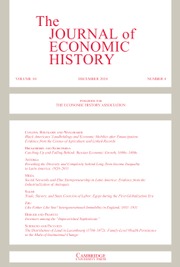Inventing Ideas examines the development of the knowledge economy during the first and second industrial revolutions and, by extension, the origins of modern economic growth. It ranges from seventeenth-century England to twenty-first century China— with prolonged sojourns in America and France—but despite this scope and ambition, it presents a coherent intellectual agenda and one that is supported with appreciable empirical detail. Professor Khan advances a crucial distinction. On the one side, she posits “administered systems” of innovation—that is, where state or private institutions assume responsibility for decisions concerning the input of resources into innovation and the rewards that accrue to innovators. Historically, the most common and varied of these administered systems were prizes. Prizes, for instance, could be offered ex ante to the innovation’s accomplishment, that is, administrators designated a specific innovation they sought to encourage and offer a prize. The archetypal example was the Longitude awards offered by the British government in the eighteenth-century for the development of methods to determine longitude at sea. Prizes might also be awarded ex post to the innovation, classically in an open competition at an industrial fair (e.g., the Great Exhibition of 1851). Prizes could also be pecuniary or honorary (medals, for instance). Conversely, there are “market-oriented institutions” where the decisions concerning resource input and output in innovations are delegated to the market. In this instance, the inventor might choose to commercialize their invention with the protection of a patent, preventing others from freely adopting their innovation.
If we boil this distinction down to prizes versus patents, the latter are now increasingly disparaged as monopolistic and impedimentary to sequential technological development, while the former was presented as a panacea, offering incentives to invent that are at least as effective as patents, but at a socially trivial cost. Bracingly, Khan has little time for this fashion or its proponents, no matter how distinguished they are. Nobel prize winners who have voiced support for awarding prizes and limiting the role of patents are dismissed as having “no specialized expertise in intellectual property” (p. 32). Supreme Court decisions are lambasted as “ahistorical,” reached “without any inquiry into the actual empirical patterns” of invention (p. 35).
It is precisely this inquiry Khan presents, and she details how poorly these prize systems have operated in practice: the recurrent stories of panel members awarding prizes to their professional allies, or prize funds being cannibalized by administrative costs, may induce déjà vu for those working in research. Some of the failings described can be attributed to the individual idiosyncrasies of the institution awarding the prize— but by adopting an international, comparative perspective, Khan demonstrates that efforts to encourage innovation by awarding prizes are intrinsically flawed: prize funds can never be as accurately calibrated as market prices in order to incentivize an invention relative to its commercial value (pp. 68-9). Consequently, the indices of prizewinning inventions, be it in the United States, Britain, or France, are virtually barren of any significant development. Chapter 5 offers a detailed case study of the Royal Society of Arts. From 1754-1782, as the classic period of the Industrial Revolution began, some 6,000 cash prizes were offered to induce specific innovations. Around one-third of these prizes were successfully claimed, but it seems that none of these 2,000 innovations ever proved to be of any commercial of technical significance. For any innovation of any real significance, greater rewards existed via the market. From a more theoretical perspective, Khan concludes that prizes suffer from the same failures as monopsonies. Ultimately, even the most august institutions of the nineteenth century admitted their failure to induce important new inventions, and Khan argues convincingly against repeating the mistake.
As important as this contribution is—and Khan makes sure to spell out the implications of her work for current policy debates—the book does much more than this. To take one example, Chapter 11 presents a concerted effort to analyze the international market in patents and inventions in the late nineteenth century, a topic that has been relatively neglected. Khan establishes that an increasing proportion of inventors were patenting their innovations in foreign jurisdictions, and consequently, introducing and commercializing technology there. This chapter marks an important first step in the study of this topic. Yet, many questions remain unanswered, such as: What was the enabling role of improving communications? What are the implications of the globalizing market in technology for the transition to self-sustaining economic growth?
Khan’s volume will hopefully make the historical debate of the best way to induce innovation accessible to a broad audience. The volume is written in accessible language, and the editors probably gave up some of the referencing in important parts with this in mind, for example, when empirical detail is unreferenced on p. 75, when direct quotations are unattributed (e.g., p. 101), or when some of the footnotes appear to be incomplete (e.g., n.11 on p. 236). Hopefully, this will not undermine the persuasiveness of this important book.


